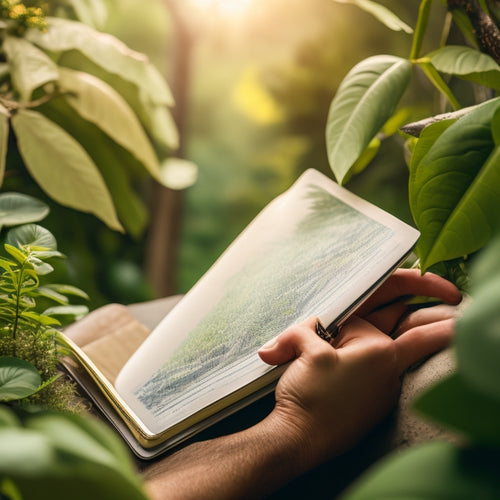
Why Track Home Energy Use? Software Solutions Explained
Share
By tracking your home energy use, you can pinpoint exactly where your energy dollars are going, identify areas of waste, and make informed decisions to reduce your utility bills and carbon footprint. With advanced data analysis, you'll reveal usage trends, peak consumption periods, and energy-wasting areas like inefficient lighting and appliances. By understanding your energy consumption patterns, you'll be able to implement strategies to shift usage to off-peak hours, optimize energy efficiency, and even reduce your reliance on external energy providers. Now, take the next step to cut energy waste and costs, and uncover the full potential of energy tracking software solutions.
Key Takeaways
- Tracking home energy use helps identify areas of inefficiency, reducing energy bills and carbon footprint through informed adjustments and behavioral changes.
- Real-time monitoring tools provide instant visibility into energy consumption patterns, enabling timely corrective actions and optimization of energy efficiency strategies.
- Energy literacy is enhanced through clear understanding of consumption patterns, empowering homeowners to make conscious energy choices and reduce overall consumption.
- Control over energy usage is achieved through proactive adjustments based on real-time data, supporting long-term sustainability goals and reducing reliance on external energy providers.
- Software solutions facilitate participation in energy-saving programs and initiatives, providing personalized recommendations to reduce energy waste and costs.
Understanding Energy Consumption Patterns
Pinpointing exactly where your energy dollars are going is essential to making a dent in your utility bills. To do this, you need to understand your energy consumption patterns.
Advanced data analysis helps you identify usage trends, behavioral patterns, and peak consumption periods. By examining your household habits, you can create an energy forecasting model that predicts your future energy needs.
By optimizing your solar panel array design, including factors such as tilt and orientation, you can maximize energy production and reduce waste. This analysis provides you with usage metrics, consumption benchmarks, and efficiency ratings that enable you to make informed decisions.
With this information, you can optimize your energy use, reduce waste, and save money. By taking control of your energy consumption, you're one step closer to achieving energy independence and financial freedom.
Identifying Energy Wasting Areas
Frequently, homeowners are surprised to uncover that seemingly insignificant habits and overlooked areas in their homes are silently draining their energy resources. By conducting energy audits and analyzing your consumption habits, you can identify areas where energy is being wasted. This helps you pinpoint opportunities to make changes and reduce your energy bills.
| Energy Wasting Areas | Potential Savings |
|---|---|
| Inefficient lighting | 10-20% |
| Unsealed air leaks | 5-10% |
| Old appliances | 5-15% |
| Poor insulation | 10-25% |
| Unused electronics | 5-10% |
Optimizing Energy Efficiency Strategies
You've identified areas of energy waste in your home, now it's time to optimize your energy efficiency strategies. To do this, you'll need to conduct an energy audit to pinpoint opportunities for improvement, considering renewable energy sources like solar and wind power to reduce your carbon footprint.
Additionally, incorporating eco-friendly stops with solar canopies and rainwater systems can further enhance your sustainable living space.
Consider smart home automation to streamline energy use, and utilize real-time monitoring tools to track your progress.
Energy Audit Essentials
Conducting a thorough energy audit is your first step in optimizing energy efficiency strategies, as it helps identify areas of energy waste in your home. This process involves an extensive assessment of your home's energy usage, providing you with a clear understanding of where energy is being wasted.
To get started, you'll need energy audit tools, such as an energy audit checklist, to guide you through the process. Considering the significant energy savings potential of solar-powered stations, it's crucial to prioritize energy efficiency in your home.
Additionally, understanding your energy usage patterns can help you take advantage of potential tax credits and grants.
- Using energy audit software to analyze your energy usage data
- Conducting energy audit assessments to identify areas of improvement
- Reviewing energy audit reports to understand your energy usage patterns
- Implementing energy audit methods to reduce energy waste and optimize efficiency
Smart Home Automation
With a clear understanding of your energy usage patterns from the energy audit, you're now ready to take the next step in optimizing energy efficiency strategies. This is where smart home automation comes in.
By integrating smart devices, you can automate energy-saving practices, ensuring your home runs efficiently even when you're not there to monitor it. With the ability to utilize renewable energy integration and incorporate decentralized charging networks, you can further reduce your reliance on fossil fuels.
Smart thermostat features, like geofencing and scheduling, allow you to optimize your heating and cooling usage. Home automation benefits don't stop there; you can also control lighting, appliances, and security systems remotely.
This level of control gives you the freedom to make energy-conscious decisions, reducing your carbon footprint and saving you money on your utility bills. By automating your energy efficiency strategies, you're taking a significant step towards a more sustainable future.
Real-Time Monitoring Tools
As you investigate deeper into optimizing energy efficiency strategies, real-time monitoring tools emerge as an essential component in tracking home energy use.
These tools provide instant visibility into your energy consumption, enabling you to identify areas of inefficiency and take corrective action. With real-time monitoring, you can track energy usage patterns similar to those of solar-powered EV chargers, which contribute to a greener environment.
By integrating renewable energy sources, you can reduce your carbon footprint and reliance on the grid. Track energy usage in real-time, receiving alerts when consumption spikes.
Compare your energy usage to benchmarks, identifying opportunities for improvement. Analyze energy analytics to understand usage patterns and optimize your energy strategy.
Receive personalized recommendations for reducing energy waste and saving money.
Monitoring Renewable Energy Output
You've invested in renewable energy sources like solar panels or wind turbines to power your home, and now you want to track their performance.
With output tracking software, you can monitor your renewable energy production in real-time, gaining knowledge into your energy generation. This data helps you optimize your solar performance and wind energy output, ensuring maximum efficiency.
Generation monitoring also enables you to identify potential issues and make data-driven decisions to improve your system's efficiency.
Furthermore, you can analyze your energy production data to determine how much energy you're feeding back into the grid, and optimize your grid integration.
Reducing Energy Bills and Emissions
By pinpointing areas of inefficiency in your home, you can cut energy waste now and lower your carbon footprint.
Simple adjustments, such as sealing air leaks and upgrading to energy-efficient appliances, can make a significant impact.
Cut Energy Waste Now
Cut Energy Waste Now (Reducing Energy Bills and Emissions)
By tracking your home energy use, you can identify areas of energy waste and take control of your energy consumption. This is vital for energy conservation and reducing your energy bills.
Making behavioral changes, such as turning off lights and appliances when not in use, can have a significant impact.
Here are some ways to cut energy waste now:
- Identify energy-intensive appliances and replace them with energy-efficient alternatives
- Adjust your daily habits to reduce energy consumption, such as taking shorter showers
- Seal air leaks and add insulation to prevent heat loss
- Use smart plugs to turn off appliances when they're not in use
Lower Carbon Footprint
Reducing energy waste is just the first step in minimizing your environmental impact. By tracking your home energy use, you can take control of your carbon footprint and reduce your energy bills. Implementing sustainable living practices and carbon offsetting strategies can further minimize your impact on the environment.
| Benefits | Actions |
|---|---|
| Reduce Energy Bills | Adjust thermostat settings, turn off lights/appliances when not in use |
| Lower Carbon Emissions | Invest in solar panels, use energy-efficient appliances |
| Increase Energy Efficiency | Seal air leaks, upgrade to energy-efficient windows |
| Promote Sustainable Living | Use public transport, carpool, or bike to work |
| Support Renewable Energy | Invest in renewable energy certificates, support green projects |
Making Informed Energy Decisions
Tracking your home's energy use enables you to make informed energy decisions, as it provides a clear understanding of where energy is being consumed and wasted.
With this knowledge, you can:
- Identify areas for improvement, increasing your energy literacy and equipping you to make conscious choices
- Implement behavioral changes to reduce energy consumption, such as adjusting your thermostat or switching to energy-efficient appliances
- Optimize your energy usage patterns to reduce waste and lower your energy bills
- Take control of your energy usage, making you more self-sufficient and less reliant on external energy providers
Frequently Asked Questions
Can Energy Tracking Software Be Used for Commercial Properties?
You're wondering if energy tracking software is limited to homes. Not at all! You can use it for commercial properties too, releasing energy efficiency and significant cost savings - in fact, 30% of commercial buildings waste energy due to inefficient systems, and you can change that.
Do Energy Tracking Systems Work With Older Homes?
You can optimize energy efficiency in your older home with tracking systems, identifying areas for home upgrades, and implementing cost-effective solutions to increase energy savings and freedom from wasteful energy consumption.
Are Energy Tracking Apps Compatible With All Smart Meters?
Smartly scrutinizing smart meter compatibility, you'll find that most energy tracking apps seamlessly sync with modern meters, providing precise observations into your energy usage trends, enabling you to optimize consumption and claim control over your household's hydro habits.
Can Energy Tracking Data Be Shared With Utility Companies?
You can share energy tracking data with utility companies, but make certain you understand data privacy terms and opt-in agreements, as some platforms prioritize utility partnerships, allowing for seamless data exchange while protecting your freedom to control your energy usage.
Are Energy Tracking Software Solutions Available for Renters?
You're wondering if energy tracking software solutions cater to renters like you. Yes, they do! Many solutions focus on tenant engagement, providing energy saving tips and enabling you to take control of your consumption, even in a rental space.
Related Posts
-

Why Choose Recycled Paper for Earth-Conscious Business?
By choosing recycled paper, you'll greatly reduce your business's environmental impact. You'll lower your carbon foot...
-

7 Best Cool Roof Rebates for Energy-Savvy Homeowners
You're an energy-savvy homeowner looking to install a cool roof, and you're wondering which rebates can help you save...
-

Why Choose Solar Composting Toilets for Your Home?
By choosing a solar composting toilet for your home, you'll greatly reduce your environmental impact, slashing your w...


